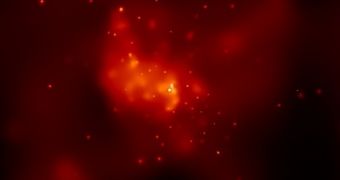The supermassive black hole (SMBH) at the center of our galaxy, Sagittarius A*, is a very quiet beast. Were it not for telltale signs such as the effects its massive gravity has on the stars surrounding it, there would be very little to say that it was there at all.
Older SMBHs like our own tend to be a lot quieter than younger ones like quasars that spew out huge amounts of energy. Still, from time to time, we get to catch a glimpse of Sagittarius A* feeding.
Since it's usually small snacks, all astronomers see are short flares that die down fast.
The brightest such flare ever observed was seen by NASA's Chandra X-Ray Observatory back in February and was described in a paper published recently in The Astrophysical Journal.
A team of scientists at MIT, the University of Amsterdam and the University of Michigan observed the flare 26,000 light years away, which was some 150 times brighter than what the black hole normally looks like.
Sagittarius A*, despite being four billion times the size of our sun regularly emits about as much light as our home star.
The fact that older SMBHs like Sagittarius A* emit so little light is a mystery, since estimates were based on the amount of material surrounding the black hole.
Flares are a regular occurrence at our black hole, but this one was the brightest ever observed.
Researchers saw a spike of 700 photos during the flare captured by Chandra. That may seem minute, but it's 150 more that they would normally see.
These events may happen a lot more often than scientists believe, they just haven't had the instruments to see them and haven't spent enough time observing SMBHs like Sagittarius A*. NASA's NuSTAR space telescope, which is sensitive to X-Ray frequencies beyond what Chandra can detect, is one such instrument, though it is inferior to Chandra in certain aspects.

 14 DAY TRIAL //
14 DAY TRIAL //